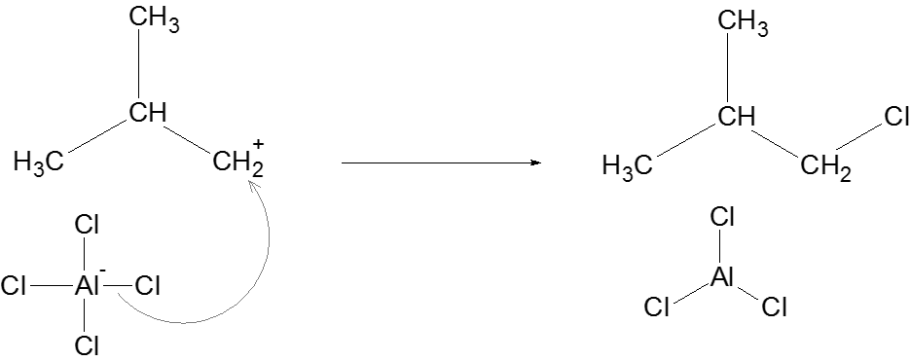
Answer
440.4k+ views
Hint: To answer this question you should recall the concept of isomerism or isomerization of alkanes. Isomers refer to compounds with similar chemical formulas but a different arrangement of constituent atoms. It is formed in the presence of a Lewis acid.
Complete step by step solution:
Process of conversion of one isomer into another is called isomerisation, in this process \[AlC{l_3} + HCl\] is used as a catalyst under high temperature and pressure.
In isomerisation n-alkanes on heating in the presence of anhydrous \[AlC{l_3}\] and \[HCl\;\] gas isomerise to branched-chain alkanes. The mechanism of the above reaction has been represented below using an alkane. For simplicity let us take a molecule of butane:
Initiation: The Lewis acid, \[AlC{l_3}\] helps in stabilizing the chloride ion from \[HCl\] when hydrogen ion is used to protonate the butene. This results in the formation of a secondary carbocation which undergoes methyl shift to form a primary carbocation.

Propagation: Another alkane attacks the newly formed carbocation, and supplies a hydride ion to the carbocation to complete this reaction involving the carbocation. The same process is followed to generate another carbocation which regenerates a carbocation at the beginning of this step.

Termination

Thus, we can conclude that the correct answer to this question is option C.
Note:
You should know about the isomerisation of an alkene. Terminal alkenes isomerize to internal alkenes in the presence of metal catalysts. An important process which involves this mechanism is Shell higher olefin process to convert alpha-olefins to internal olefins, which are subjected to olefin metathesis.
Complete step by step solution:
Process of conversion of one isomer into another is called isomerisation, in this process \[AlC{l_3} + HCl\] is used as a catalyst under high temperature and pressure.
In isomerisation n-alkanes on heating in the presence of anhydrous \[AlC{l_3}\] and \[HCl\;\] gas isomerise to branched-chain alkanes. The mechanism of the above reaction has been represented below using an alkane. For simplicity let us take a molecule of butane:
Initiation: The Lewis acid, \[AlC{l_3}\] helps in stabilizing the chloride ion from \[HCl\] when hydrogen ion is used to protonate the butene. This results in the formation of a secondary carbocation which undergoes methyl shift to form a primary carbocation.

Propagation: Another alkane attacks the newly formed carbocation, and supplies a hydride ion to the carbocation to complete this reaction involving the carbocation. The same process is followed to generate another carbocation which regenerates a carbocation at the beginning of this step.

Termination

Thus, we can conclude that the correct answer to this question is option C.
Note:
You should know about the isomerisation of an alkene. Terminal alkenes isomerize to internal alkenes in the presence of metal catalysts. An important process which involves this mechanism is Shell higher olefin process to convert alpha-olefins to internal olefins, which are subjected to olefin metathesis.
Recently Updated Pages
Who among the following was the religious guru of class 7 social science CBSE

what is the correct chronological order of the following class 10 social science CBSE

Which of the following was not the actual cause for class 10 social science CBSE

Which of the following statements is not correct A class 10 social science CBSE

Which of the following leaders was not present in the class 10 social science CBSE

Garampani Sanctuary is located at A Diphu Assam B Gangtok class 10 social science CBSE

Trending doubts
Which are the Top 10 Largest Countries of the World?

A rainbow has circular shape because A The earth is class 11 physics CBSE

Fill the blanks with the suitable prepositions 1 The class 9 english CBSE

How do you graph the function fx 4x class 9 maths CBSE

Give 10 examples for herbs , shrubs , climbers , creepers

In Indian rupees 1 trillion is equal to how many c class 8 maths CBSE

The Equation xxx + 2 is Satisfied when x is Equal to Class 10 Maths

Difference between Prokaryotic cell and Eukaryotic class 11 biology CBSE

What is BLO What is the full form of BLO class 8 social science CBSE




